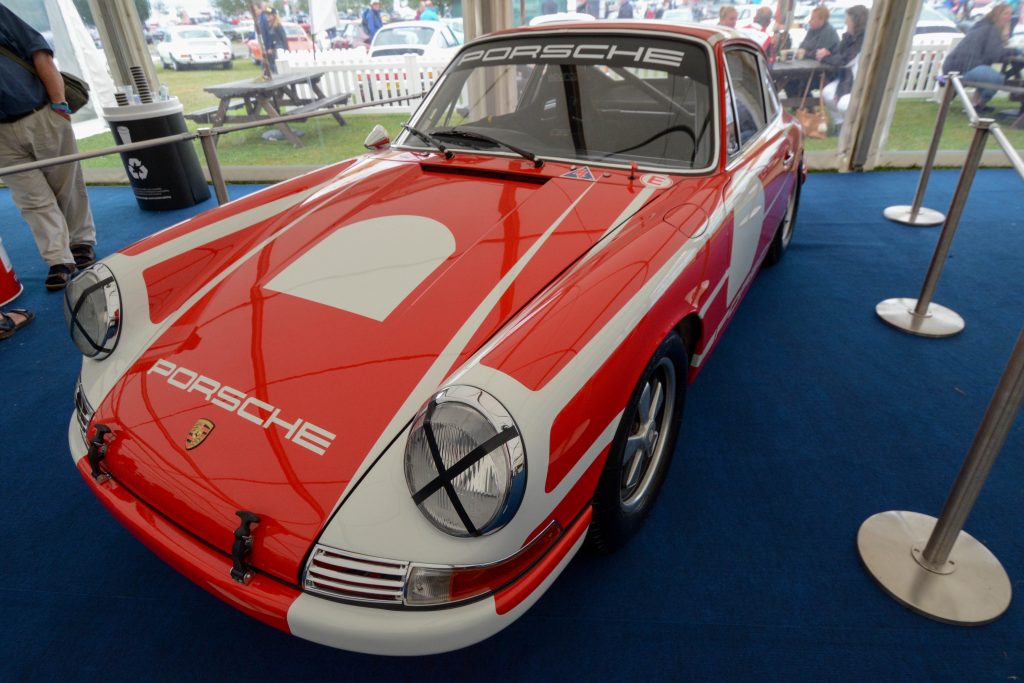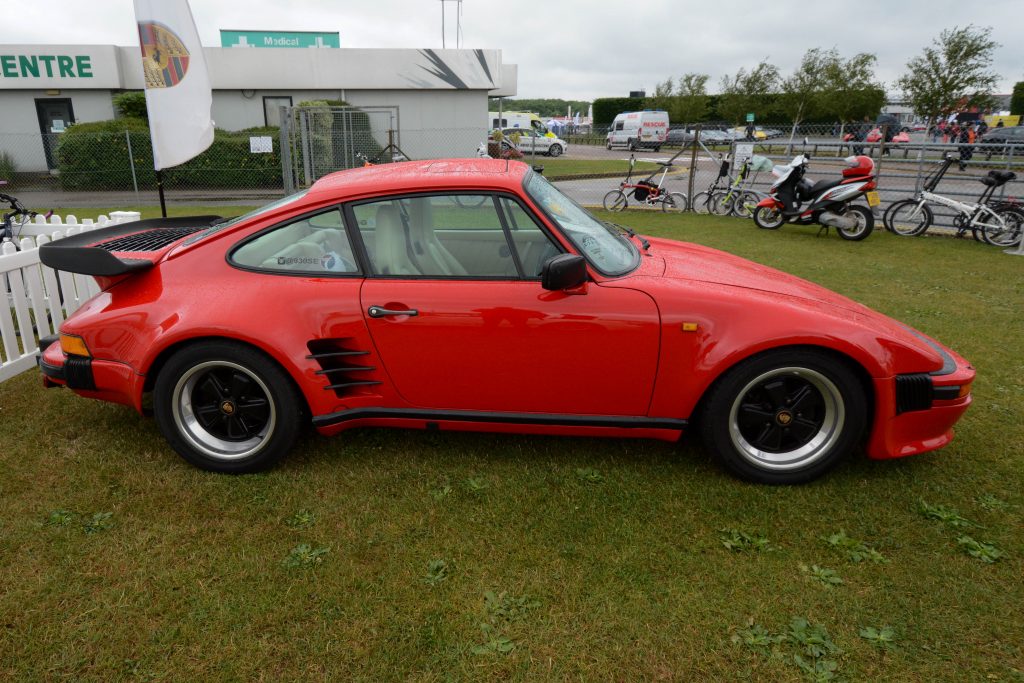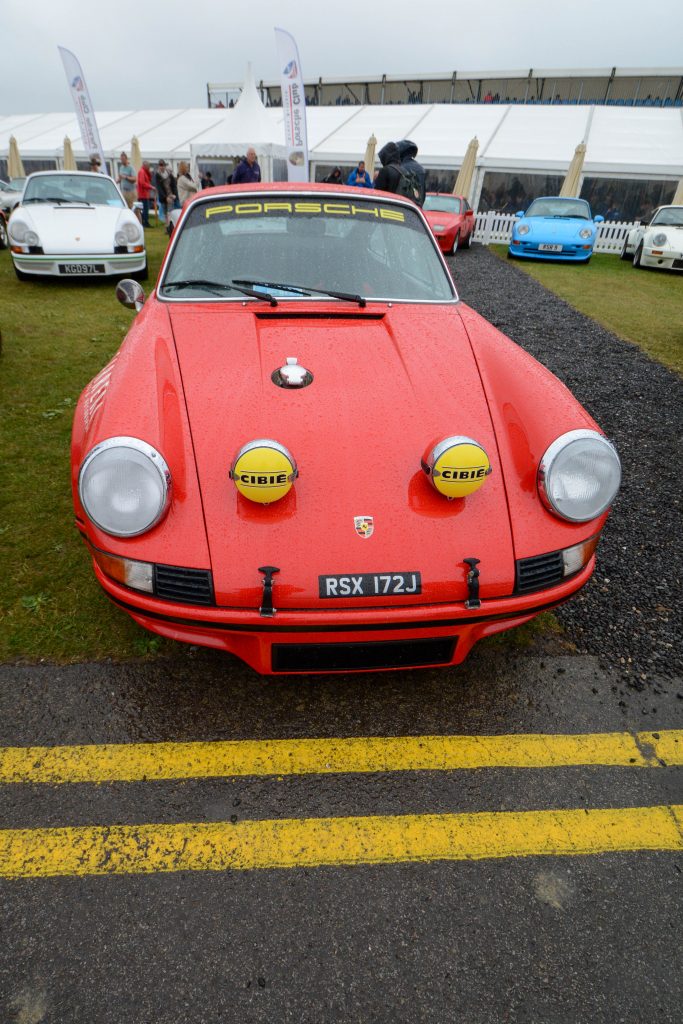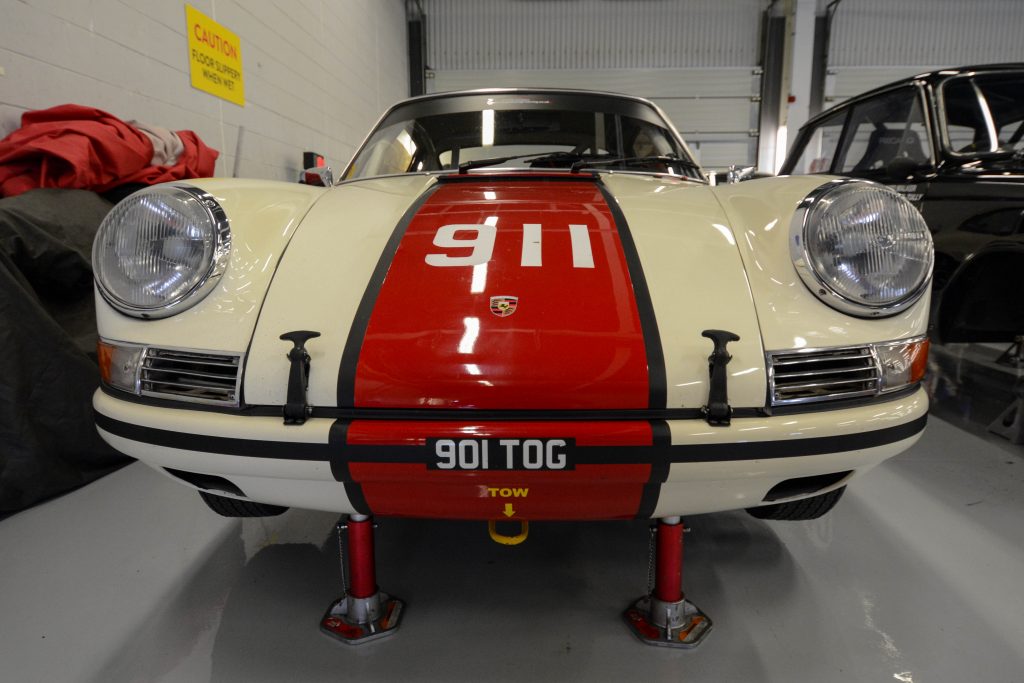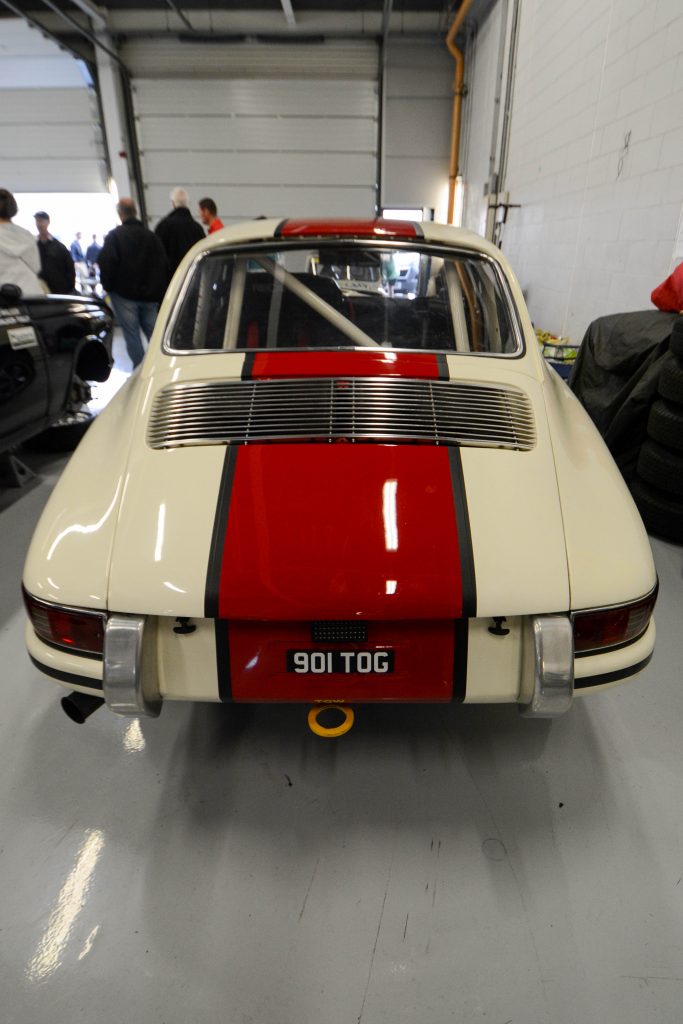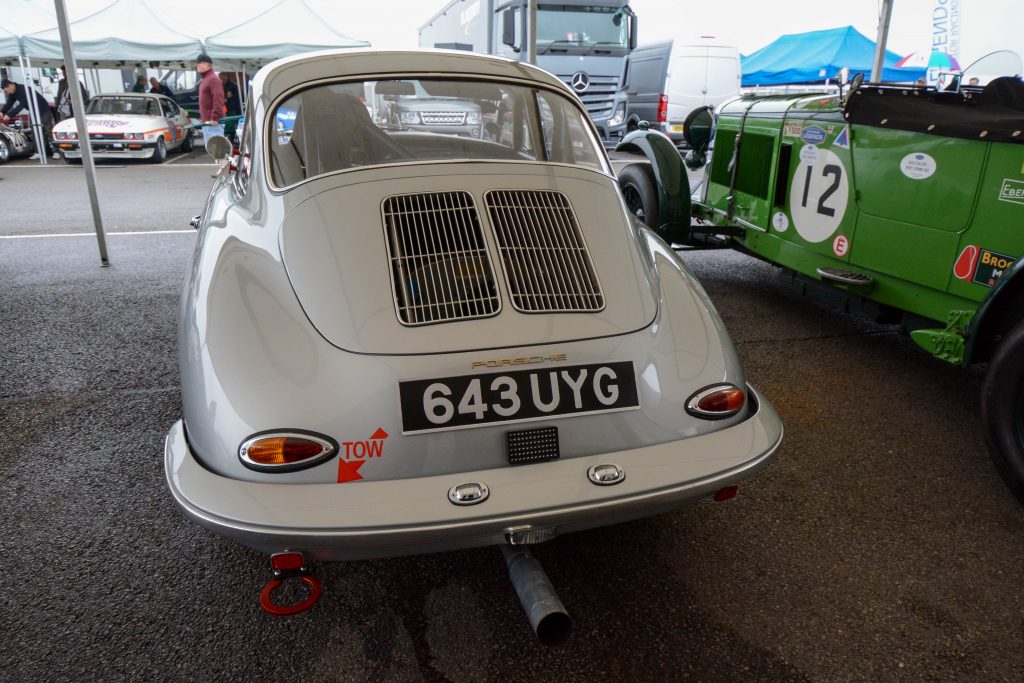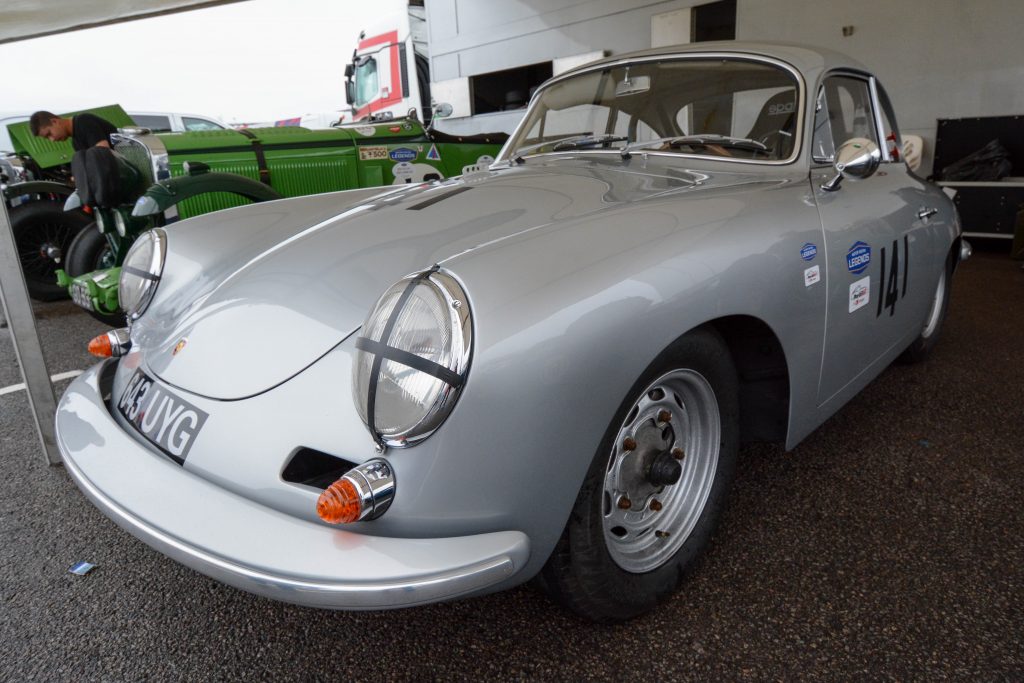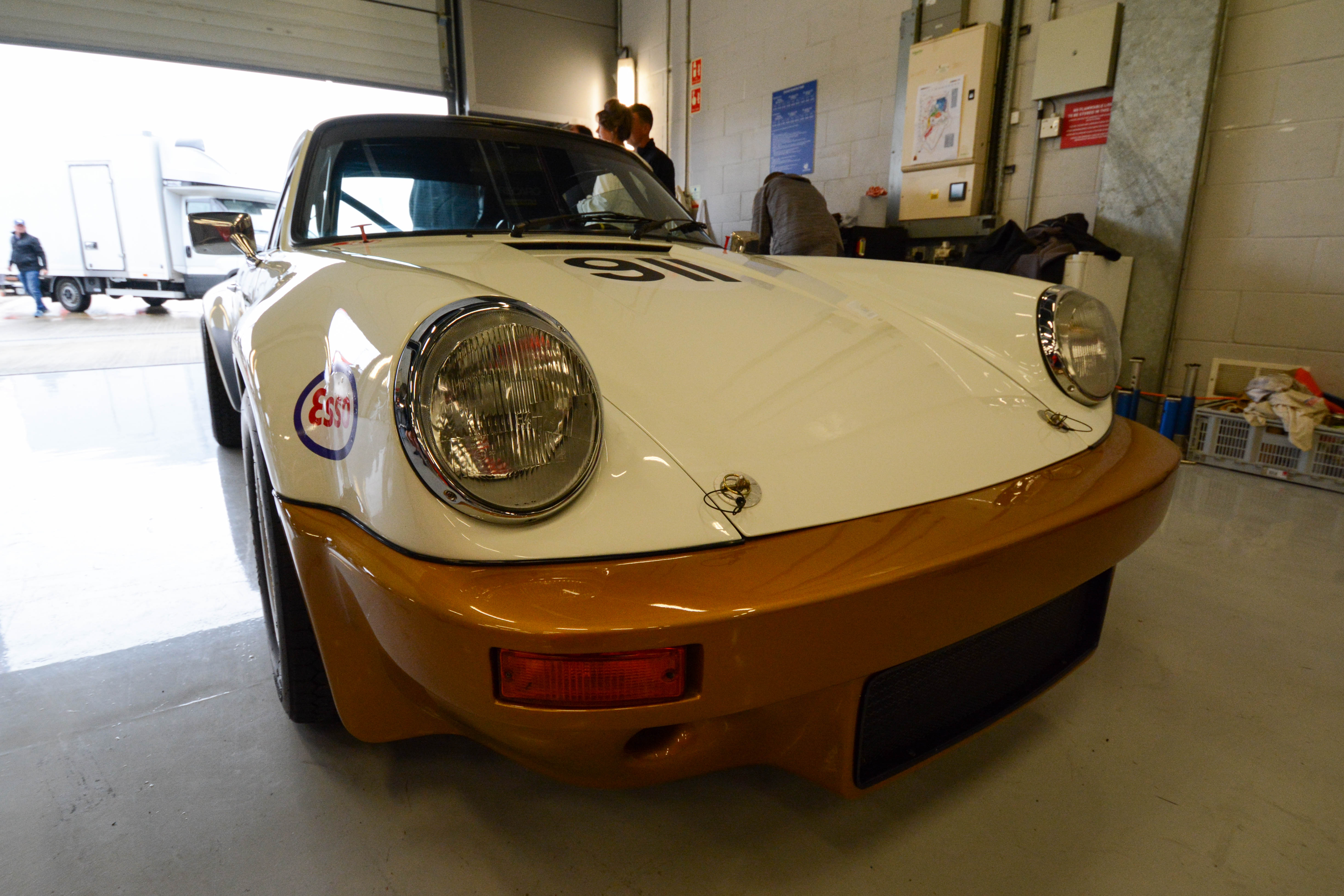In these climatically challenging times, I suppose we should no longer be surprised at how rapidly weather conditions can switch from tropical heatwave to standard UK summer drizzle but why does this always seem to coincide with seriously special classic car events?
Last year it was Luftgekühlt at Bicester Heritage which in the midst of wonderfully warm and sunny Summer, transformed into Wassergekühlt! This year, we went from sweltering 38 degree heat (in London at least) to a state of excessive sogginess for Silverstone Classic. Sigh …………. where did I leave my waterproofs and underwater camera?
Soggy Silverstone
Steady drizzle blighted Silverstone Classic for most of the day forcing me and friend Kirk to spend much of our time sheltering in the national and international pits whilst occasionally wandering across to the Porsche Club stand at the end of the Wellington Straight to see some of the slippery track action.
Mooching around the pit garages to avoid the rain wasn’t so bad however as we came across some very interesting motors including (in alphabetic order:- ……………………..
AC Cobra
AC Cobra’s are the Anglo/American thug of the racetrack. The once sublimely handsome and restrained European styling of the underlying AC Ace design is barely recognisable as a result of the Incredible Hulk like transformation involving bulging wheel arches, fat wheels and tyres and a fire breathing American (Ford) V8 engine.

There’s no denying the virility and brutal performance of these testosterone-gorged monsters but it is nice to take a wistful look back at the car’s progenitors.
To go back to the very beginning – you have the Tojeiro Barchetta, designed by John Tojeiro and borrowing many styling queues from the Ferrari Barchetta. It was a really nice surprise to come across one of these extremely rare cars at Silverstone Classic and to have the opportunity to study it close-up.

With some bodywork and mechanical modifications, this car was adopted by the Hurclock family to become the AC Ace which was launched in 1953 and remained in production until 1963. The Ace, was powered one of three straight six engines available to AC at the time. These ranged from AC’s own but rather aged 2 Litre engine, through the BMW 328 derived 2 Litre to the Ken Rudd (Ruddspeed) tuned Ford 2.6 Litre.
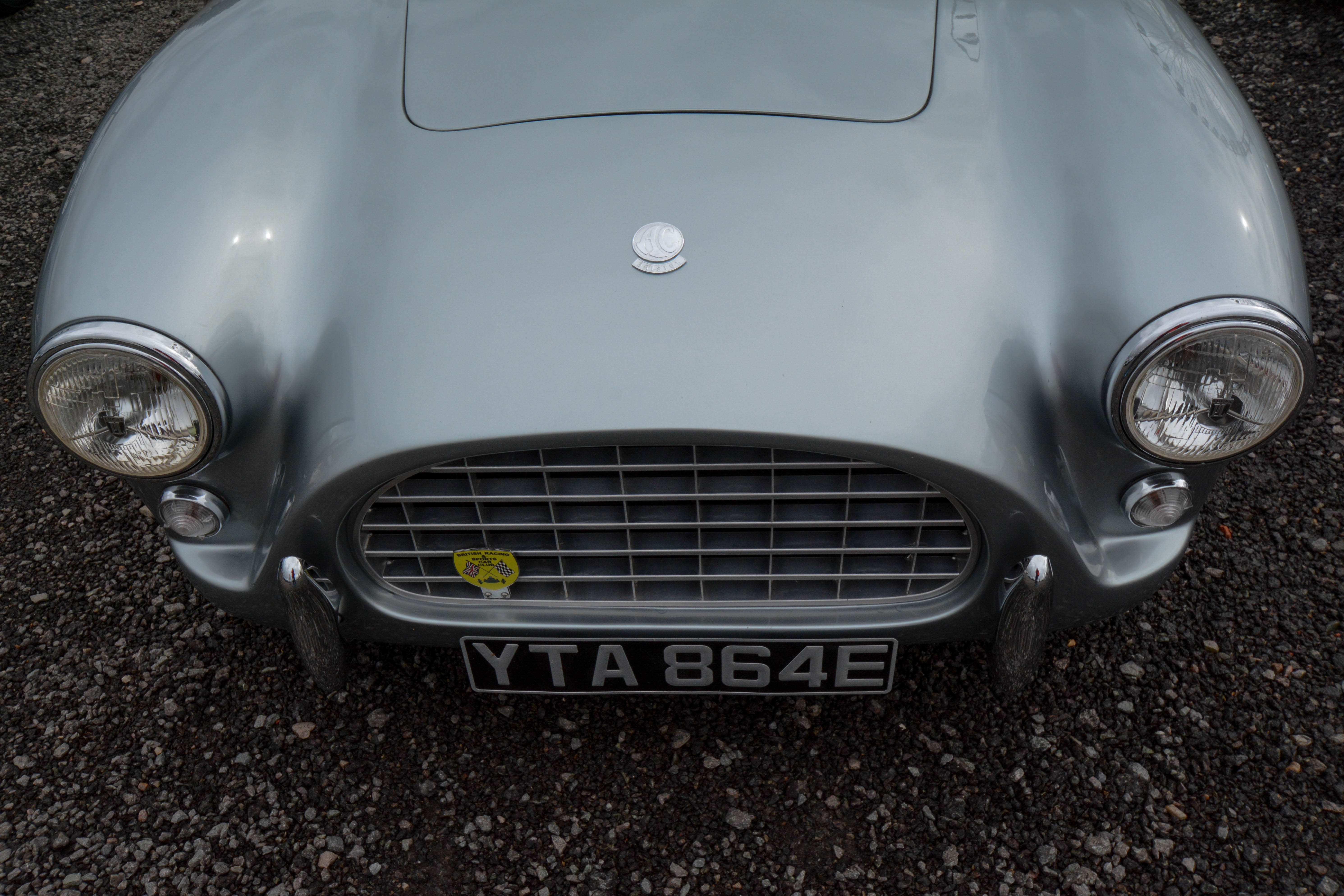
It was the Ace into which Carroll Shelby later shoe-horned a 4.7 Litre Ford V8 engine and onto which he grafted increasingly bulbous wheel arches filled with big, fat Hallibrand knock-on wheels and tyres.



There was a degree of onward development of the Cobra to deliver even more potent race performance through fitting bigger (7 Litre V8) engine and improved suspension but perhaps the most radical development was of a much more aerodynamically efficient closed coupe who’s bodywork was far removed from the Ace and Cobra. This radically different car was developed to more effectively compete at high speed circuits against Ferrari 250 GTOs and other rapid GT race cars.

Peter Brock was tasked by Shelby to design the bodywork of the Daytona Cobra Coupe and Bob Negstad was asked to bring his experience on the GT40 and coil-spring Cobra to bear on the suspension. In the end, just six cars were built, the first at Shelby HQ in Venice, California and the remaining five were constructed by Carrozzeria Gransport in Modena, Italy.

During the 1964 and 1965 racing seasons the Daytona Coupe achieved no less than nine GT class wins at a range classic circuits across the USA and in Europe.
Alfa
Alfa’s of any age are interesting and invariably stylish motors but pre-war Alfa’s are in a league all of their own. Their style and sophistication was recognised and acknowledged by the motoring cognoscenti of the time and this was underpinned by phenomenal success in road and on track races.
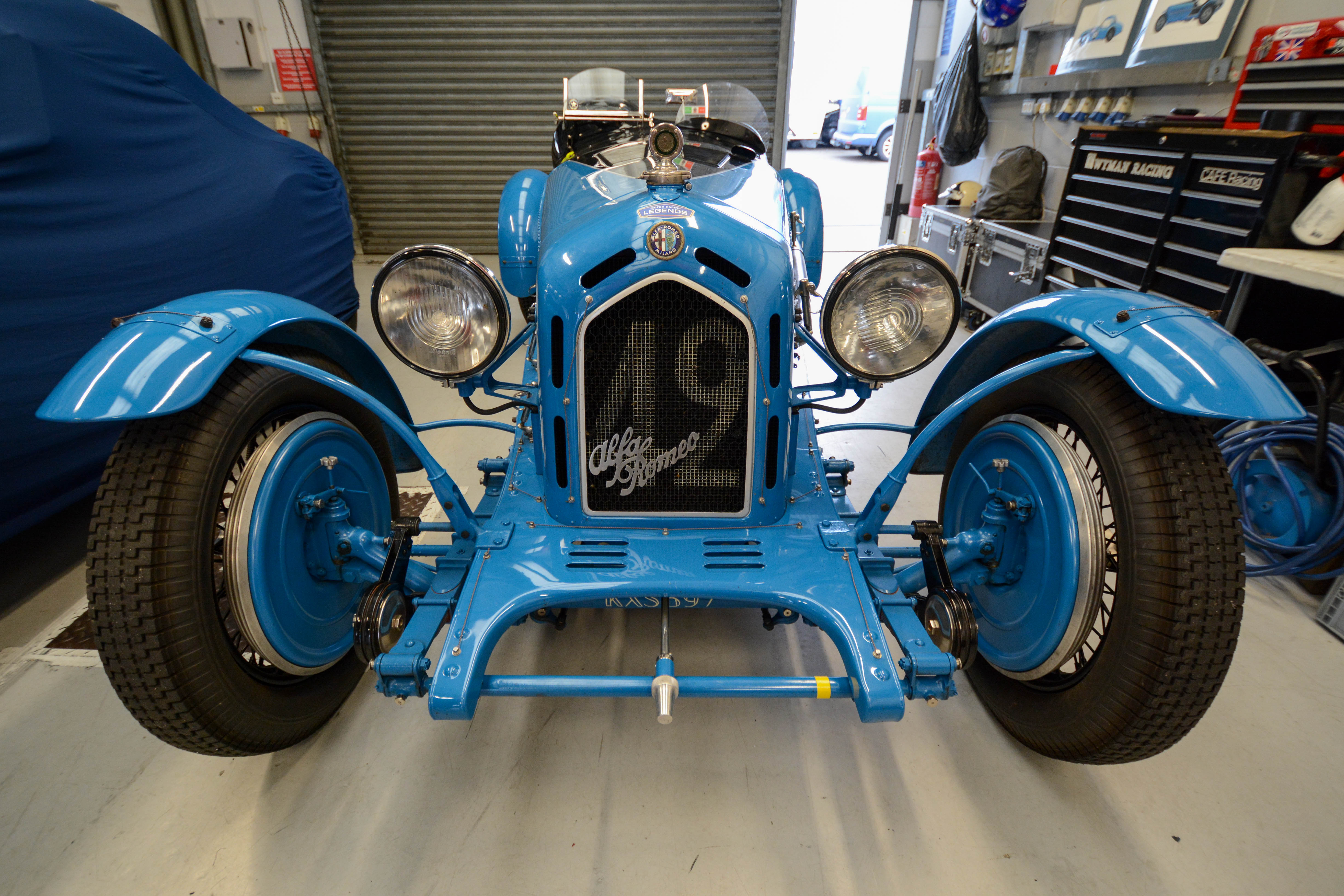
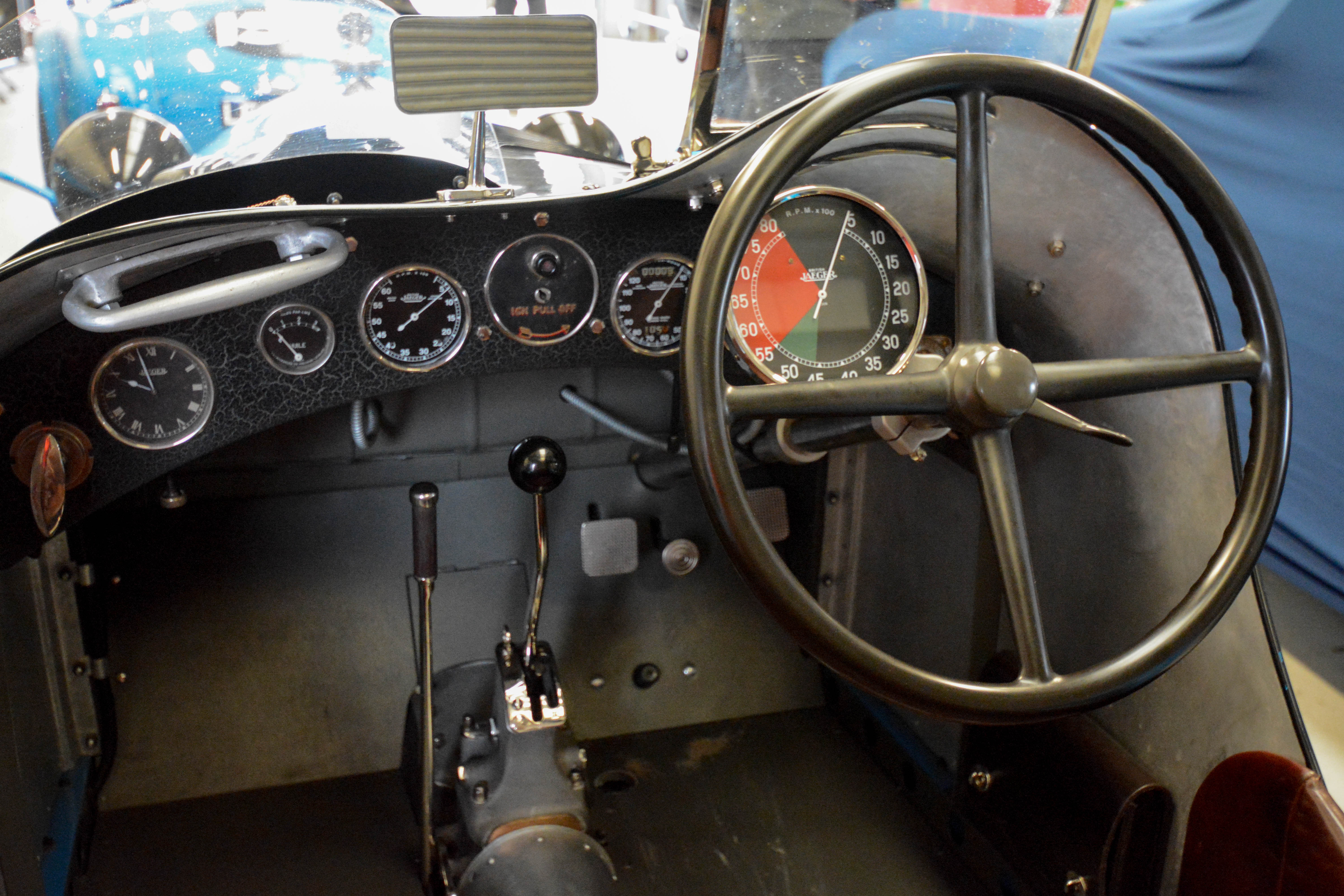
The interior of this 8C Monza is really interesting and surprisingly modern in its layout. It has a wonderful array of gauges to keep the driver fully informed and aware of all of the engine’s vital signs and some indication of vehicle velocity. Most prominent of all however is the massively oversized rev-counter mounted on the steering column just behind the steering wheel leaving no doubt about the racing intent of this car.
Whilst we might take the centrally placed gear change and handbrake for granted, many contemporary cars of the period such as Bugatti and Bentley still had the more primitive arrangement of gear and handbrake levers outside of the cockpit, fixed to the side of the car.
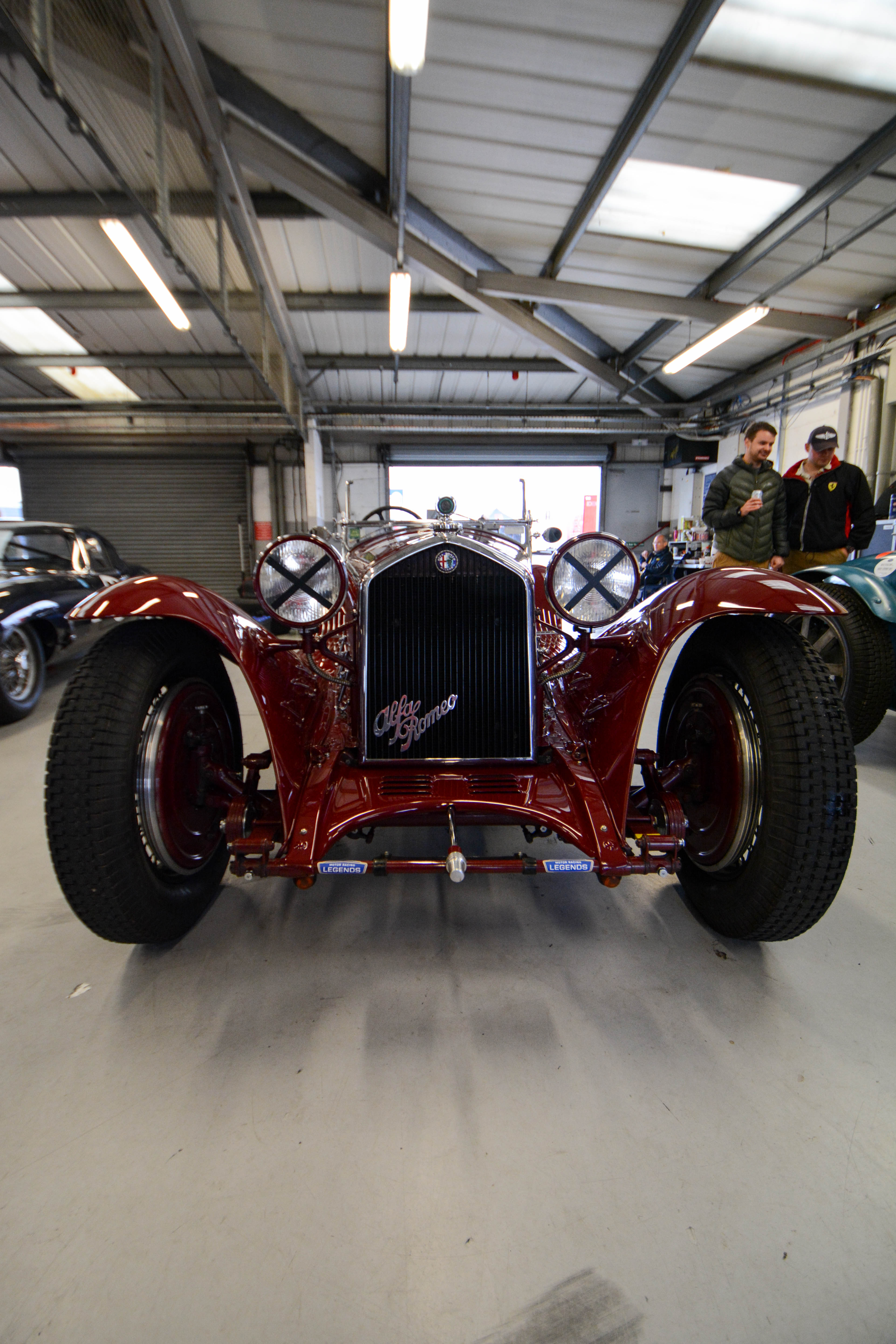
The 8C dominated the most prominent races during the early ’30’s including the Mille Miglia, Le Mans and the Targa Florio. The fabulous straight-8 engine powering the 8C was a product of the engineering brilliance of Vittorio Jano.
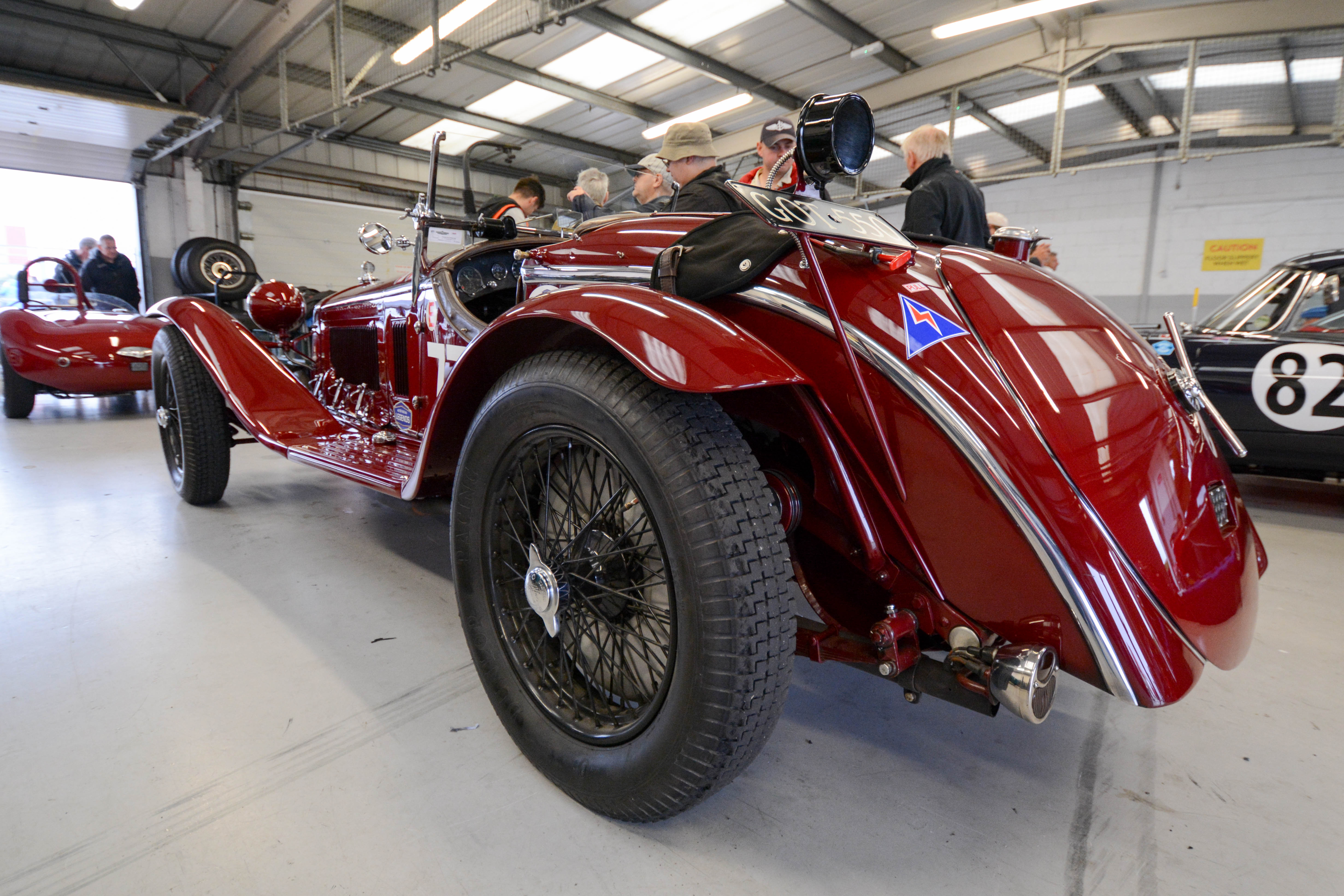
By the mid to late ’30’s however, Alfa’s period of racing dominance started to wane with the rise to prominence of Germany’s Silver Arrows.
Allard
Sydney Allard founded his eponymous company in 1946 in Clapham, South London. Allard pioneered the use of large capacity American V8 engines in customer made lightweight body/chassis units. Many cars were raced and rallied with considerable success and two notable Allard drivers of the period were Carroll Shelby (of Cobra and Mustang fame) and Zora Arkus Duntov (creator of the Corvette Stingray).
Sydney Allard therefore paved the way for many more Euro/US Hybrids which combined stylish and sophisticated European body/chassis designs with stonking great American V8 engines. European manufacturers utilising US V8 engines included:- AC, Bristol, De Tomaso, Facel, Ginetta, Iso, Gordon Keeble, Jensen, Lister, Lola, McLaren, Morgan, Sunbeam, Tojeiro and TVR.
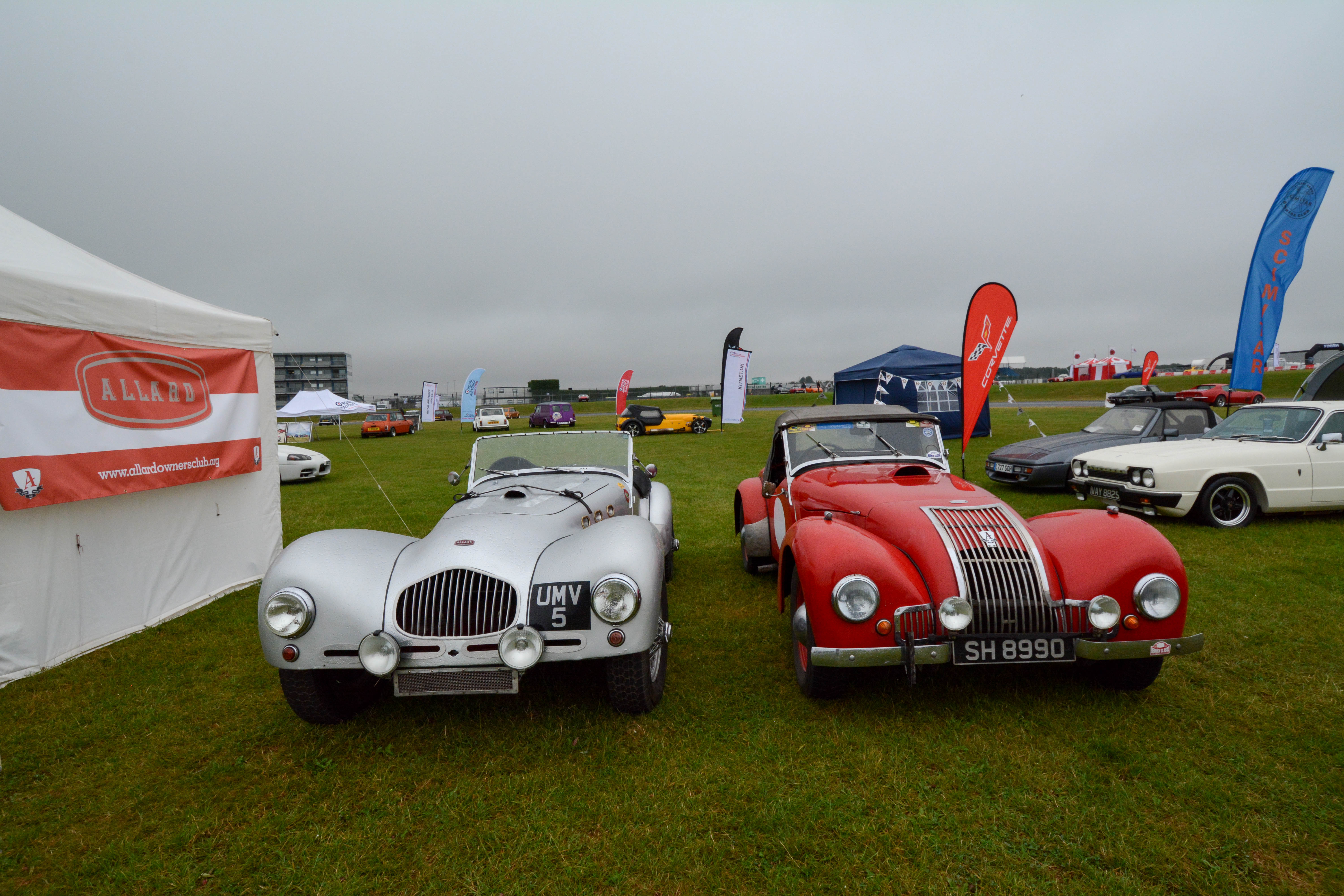
These particular Allards are two-seater sports car variants of the K-series models from 1949 and 1951 which used Ford, Mercury Chrysler and Cadillac V8 engines depending upon where the cars were being sold and upon specific engine availability.
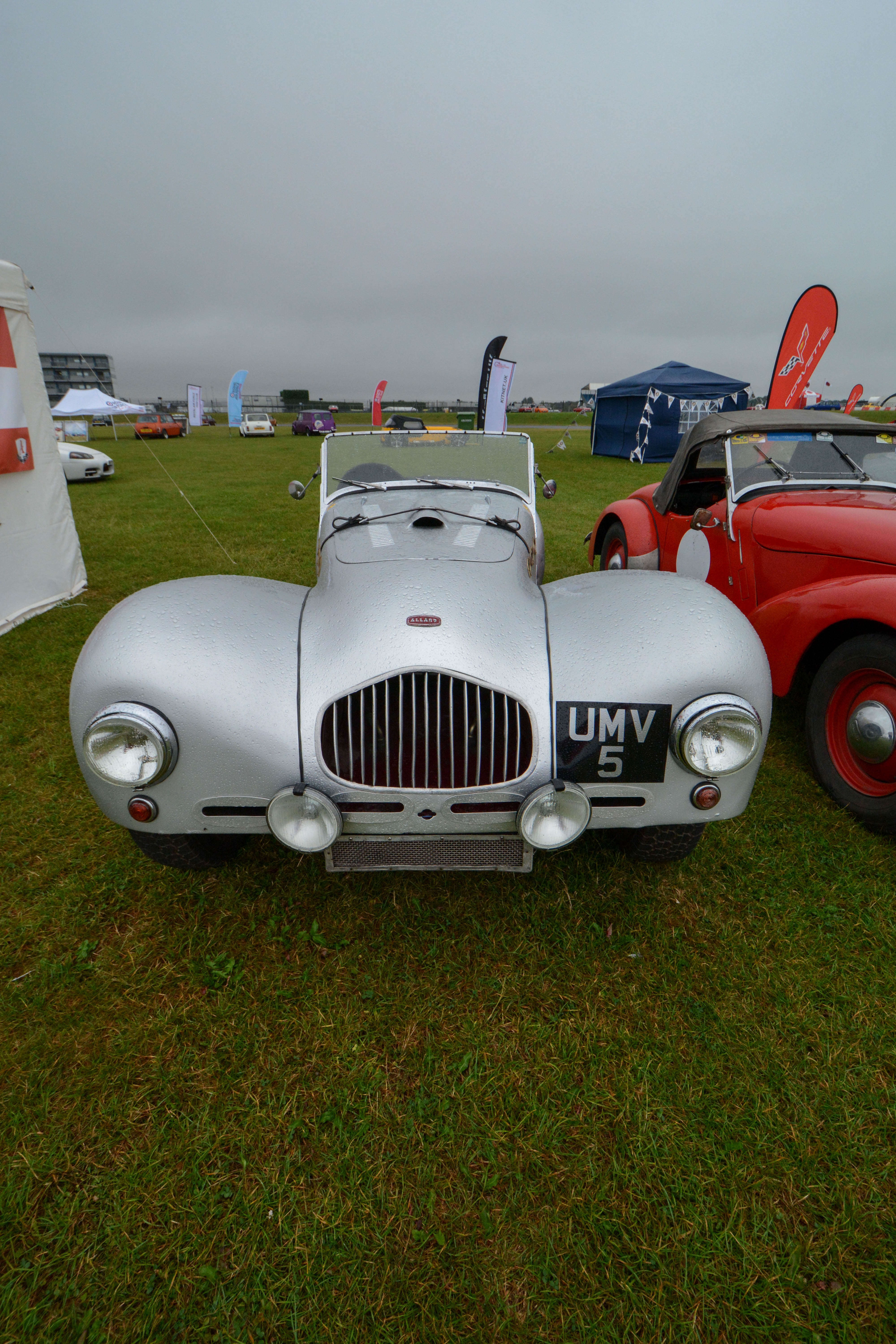
Top speed of the K series sports cars was around 86-90 mph.

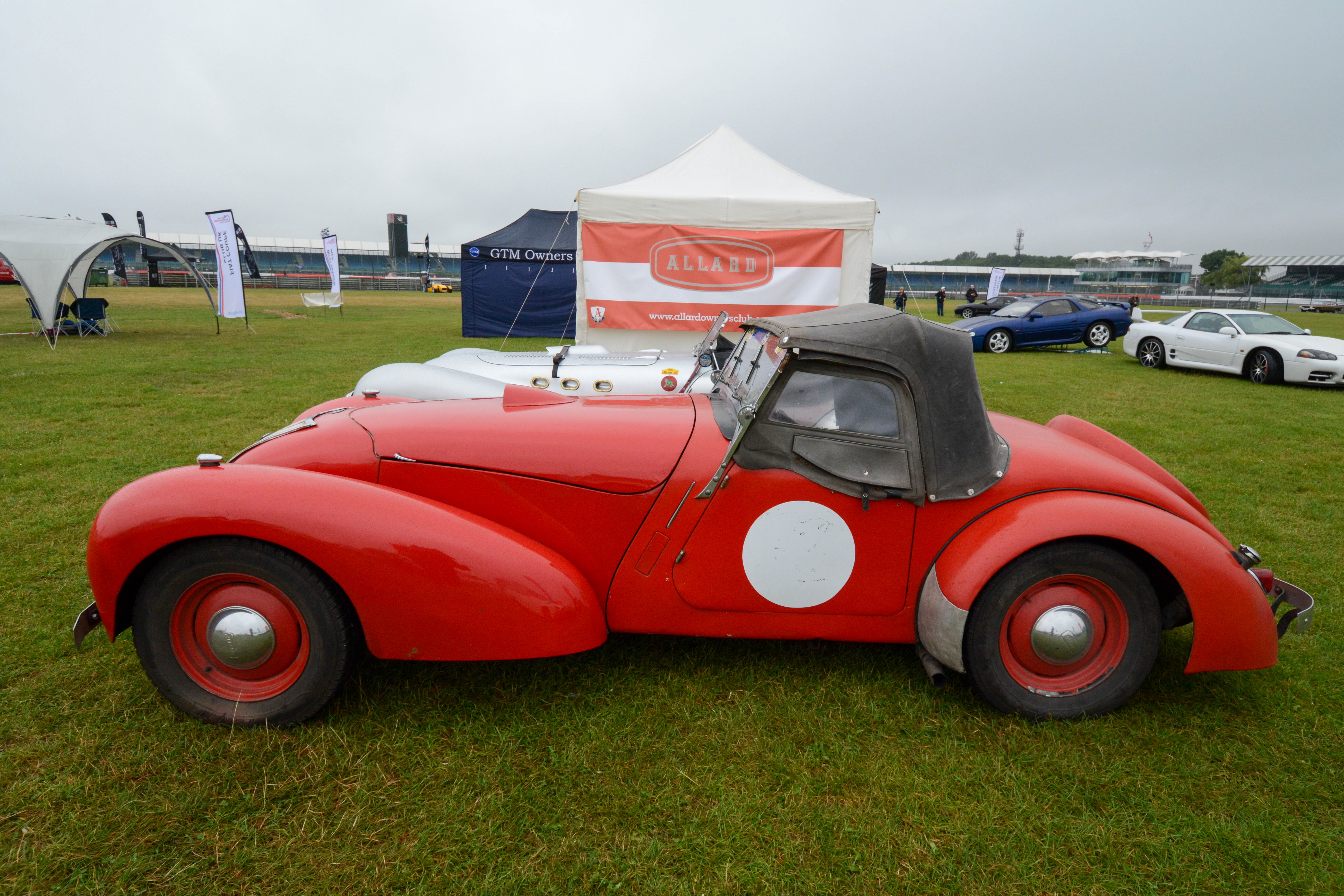

Aston Martin
During the long life of this venerable company, there have been many changes of ownership and a number of highly significant phases of car development.
Originally established by Lionel Martin and Robert Bamford in 1913, Aston Martin benefited from some additional bank-rolling in 1920 by Count Louis Zborowski. In 1924, the company was rescued from potential bankruptcy by Lady Charnwood and Augustus Bertelli, and it was subsequently rescued again by Lance Prideaux Brune and then Sir Arthur Sutherland. Finally (after WWII), it ended-up under the benevolent control on David Brown Ltd. – the Huddersfield gear and machine tool manufacturer.

Many more owners and models (too numerous to mention) were to follow after David Brown’s period of ownership ended in 1972 until the present day but I personally think that the company’s glory days were the pre-war period of Bertelli ownership and the immediate post war period of David Brown ownership.

Bertelli designed and raced some phenomenally successful race cars including the International, International Le Mans, Le Mans, Ulster and Speed models. Many of these cars are still raced at historic events to this day including at Silverstone Classic it is fantastic to see some of the Le Mans team cars lined up together just as they would have done at the La Sarthe circuit during the 1930’s.

The David Brown years took Aston into the modern era with the inspired use of wonderful Italian body styling and powerful Tadek Marek designed engines as epitomised by the DB2, DB2/4, DB MkIII, DB4, DB5, DB6 and DBS.

Of all of the various DB models, my favourites are the DB4 and DB5 as the most beautiful and stylistically perfect. The DB2 and 2/4 are quite definitely ’50s cars with bulbous cabins and a slightly heavy, agricultural look to them. The DB4 and 5 however have sublime body styling by Carrozzeria Touring of Milan and they are underpinned by a wonderfully light Superleggera chassis.
The DB6 with its extended DB5 chassis, rear lip spoiler and Kamm tail definitely improved the aerodynamics of the car by reducing lift and improving rear traction BUT it added a visual bulkiness that was absent from the earlier DB5 design.
Returning to my Aston Martin DB preferences however, I would have to say that the DB4 GT and the DB4 GT Zagato the very best of the breed with the Zagato being one of my all time favourite cars.

Aston Martin was originally formed to race cars, initially at hill climb events at venues such as Aston Clinton near Aylesbury (where the “Aston” in Aston Martin came from), then on British and continental race tracks. This led to great pre-war success at the most prestigious tracks such as Le Mans.
Interest in racing was not abated after WWII however with Aston Martin fielding racing versions of the DB1, DB2 and DB3S before finally achieving outright victory at Le Mans in 1959 with the DBR1/300 in the very capable hands of Carroll Shelby and Roy Salvadori.
Not all racing cars developed by Aston Martin were successful in their day but thankfully a number of precious survivors and replicas are still being campaigned in historic/classic car races and thanks to meticulous preparation and development they are exceeding their original performance.
DP214 is one such car. Only two examples of this prototype sports car were developed in 1963 with only one surviving example. It was an onward development of DP212 which (was in turn based upon a DB4 GT chassis). It retained the low frontal area and Kamm tail of the 212 but featured wider bodywork and a modified nose. It also utilised a 3.75 Litre straight-6 engine as opposed to the DP212’s 4.0 Litre lump.

Given that there is only on surviving original car, I assume the blue car here is a replica, in a rather vivid shade of blue rather than the more subdued Aston Martin green of the original.
Chevy
Big American cars generally leave me cold but they do provide an interesting spectacle when being flung around with with gay abandon on tight and twisty race circuits crowded with tiny (by comparison) European cars with far more diminutive engines. The resulting see-saw effect of Yank Tanks out-horse-powering everything down long straights only to be hauled-in by the lighter and more nimble motoring minnows on the bendy bits is great fun to watch.
Ford Galaxie’s and Falcons are the usual suspects that one sees tearing-up our European tarmac but this slightly more subdued Chevy Impala caught my eye in the paddock.
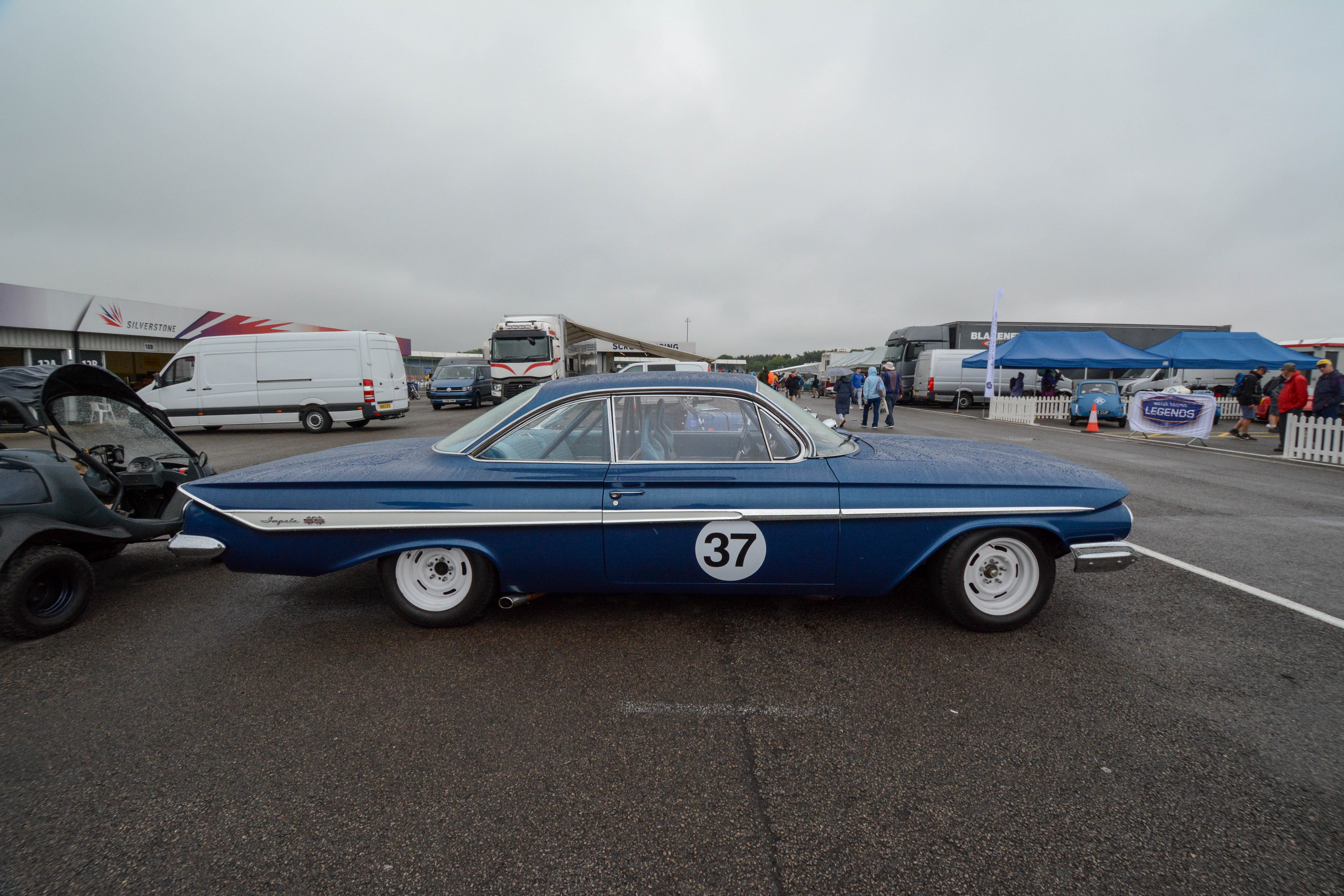
I didn’t see the Impala in action but if memory serves me correctly, one of these was campaigned by the late, great Dan Gurney.

Elva GT160 BMW
I really like this very rare little car. Only three prototype cars were made by Elva with bodywork design by Trevor Fiore at Carrozzeria Fissore.
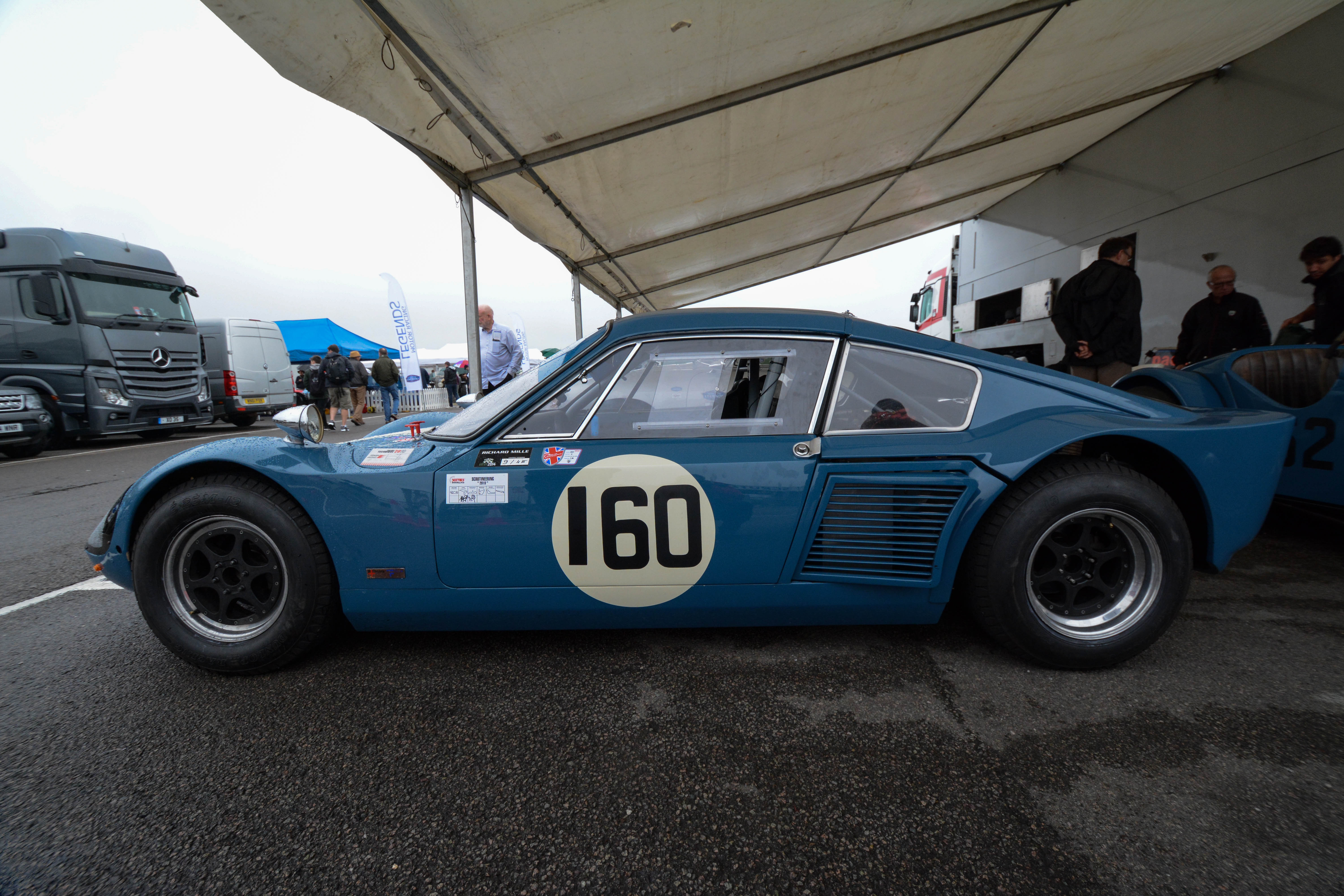
It features a sturdy looking spaceframe chassis housing a mid-mounted BMW 2.0 Litre 185 bhp engine mated to a Hewland 5-speed gearbox.

Sadly, the high build cost of the car meant that it was not economically viable to build in reasonable volumes or to be sold for a sensible price. It’s a real shame as the car look great and would have provided excellent performance (around 160 mph) thanks to its power to weight ratio (the var weighed just 600kg).
Ford
Classic saloon races are normally blessed with a few fine Fords from both sides of the pond. At Silverstone, the marque was ably represented by meaty Mustangs, a gargantuan Galaxie, lots of Lotus Cortina’s and a great GT40.

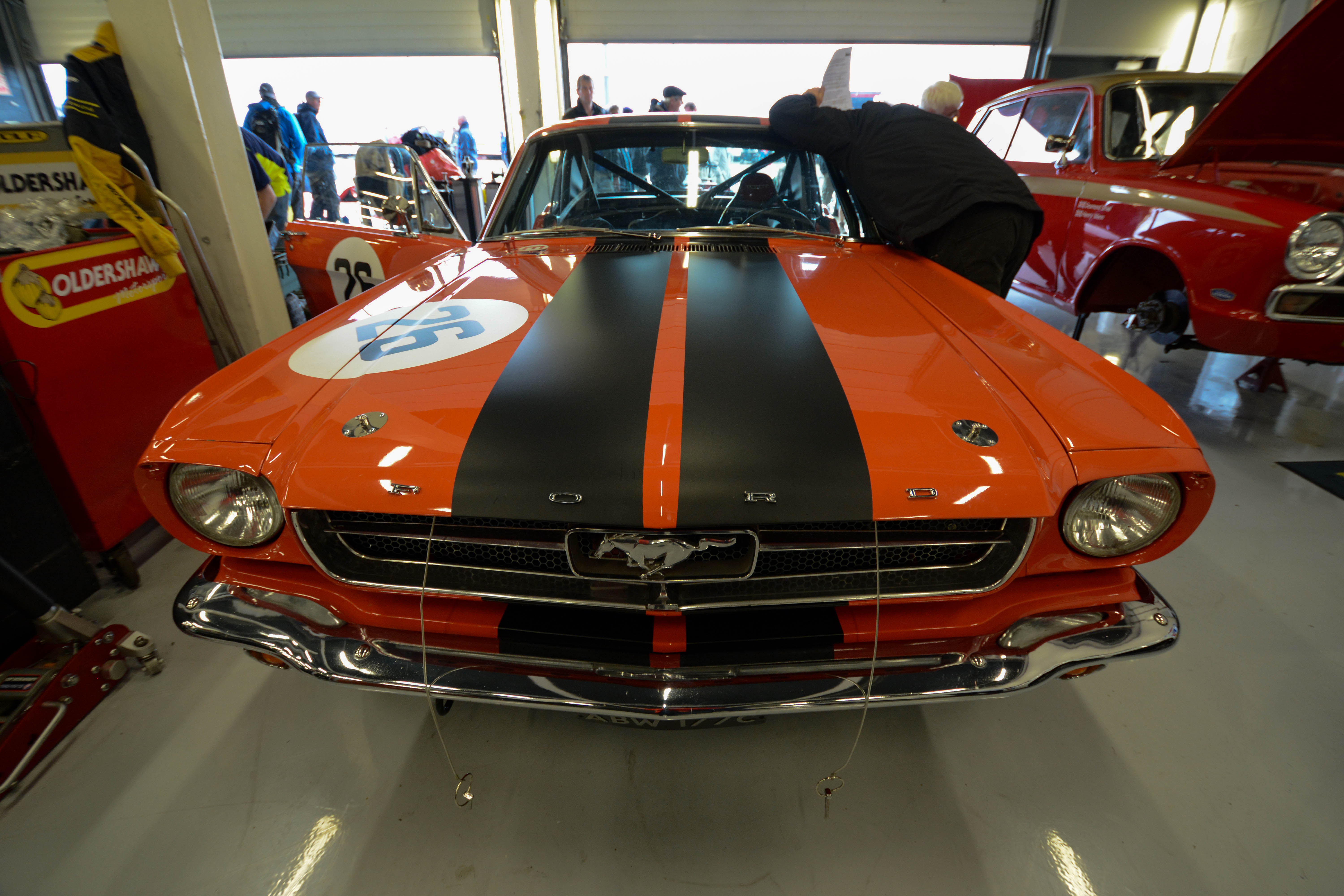


This car is just mental


GT40’s are lovely looking race cars and quite topical right now given the imminent (November in the UK) release of the Ford Versus Ferrari film which recounts the titanic battle between the two companies to achieve dominance at Le Mans. More info on this tale of REVENGE can be found here:- Pub Chat – Revenge! (Part 3).
Ford got their revenge against Ferrari by winning at Le Mans in ’66, ’67,’68 and ’69.

Firmly on home (UK) turf, the lowly Ford Cortina was developed into a highly competitive racing saloon by the insertion of a Lotus twin-cam engine into what was a relatively lightweight bodyshell. The additional tweaking of the suspension transformed it into a sharp handling front runner.

Based initially upon the Cortina MkI with its rather lovely “ban the bomb” rear tail lights, the car was rather confusingly marketed as the “Consul Cortina developed by Lotus”. This catchy name was eventually shortened down to “Cortina Lotus” for the MkII based cars but probably to Ford’s chagrin, they are now universally referred to as the “Lotus Cortina”.
The later Cortina MkII bodyshell was also given the Lotus makeover but I don’t think many people would argue that the MkI is more aesthetically pleasing to the eye!

The heart of the Lotus Cortina is the twin-cam engine based upon a Ford Kent engine with tuning work carried out by Keith Duckworth from Cosworth. The resulting 1,557 cc engine produced 105 bhp and engine power was transmitted to the rear axle via a Lotus Elan gearbox.
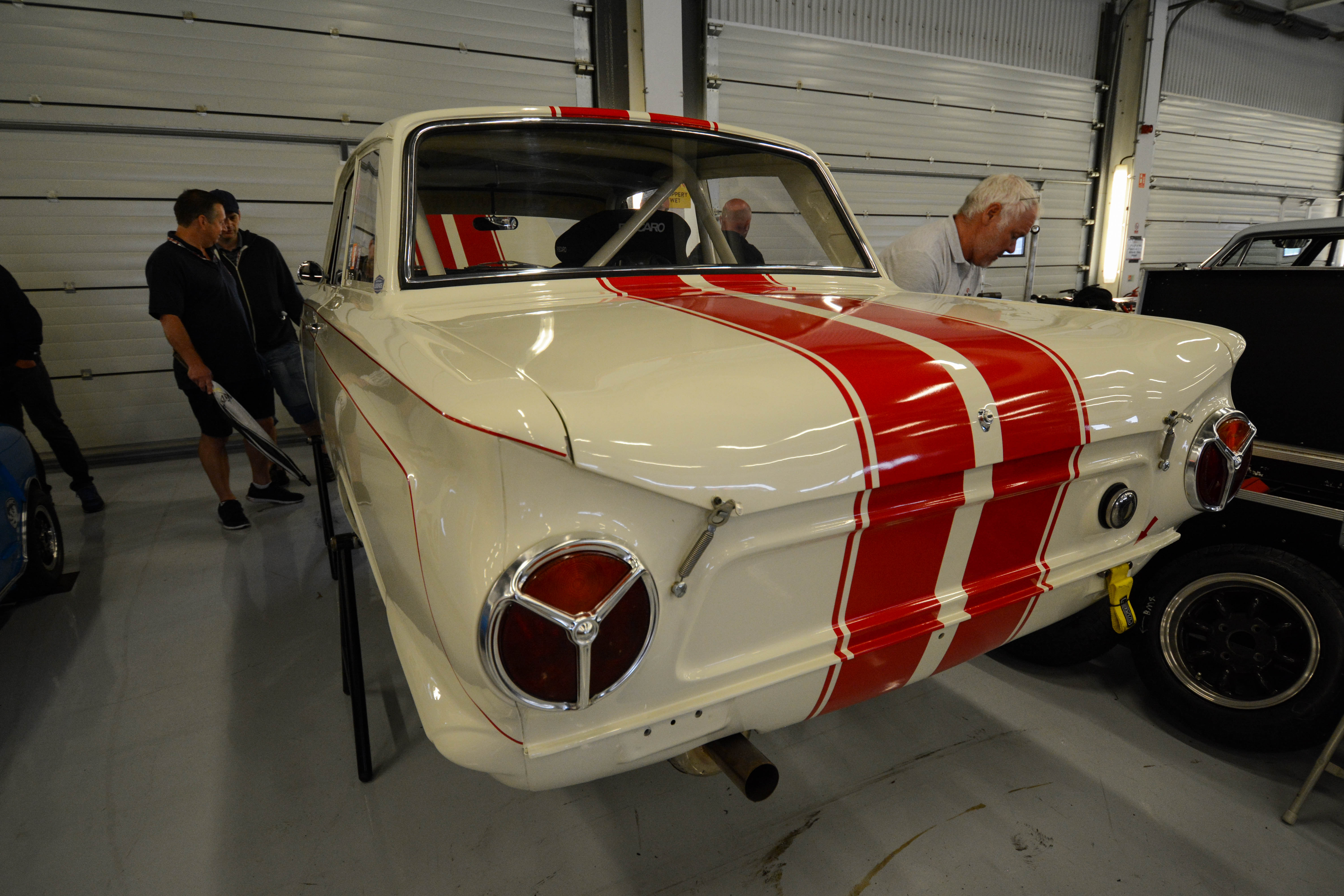
Rear suspension was highly modified and many external panels were swapped from steel to alloy to reduce weight. The end result was a powerful and eminently chuckable car which is no less popular now in historic racing events than its was during the ’60s.

Gilbern 1800 GT
Gilbern cars was founded Giles Smith and Bernard Friese in 1969 in South Wales and the company manufactured cars up until 1973. The GT pictured here was the first model the company manufactured between 1959 and 1967.

This fibreglass 2+2 GT was initially powered by the diminutive 948cc BMC A-series engine but this was eventually replaced by an MGA 1500 cc or 1600 cc engine and later still by an 1800 cc MGB engine.

From 1966, Gilbern produced the more sophisticated Genie model featuring a Ford V6 of 2.5 or 3.0 Litre capacity. The Genie was then replaced by the very similar Invader in 1969 differing only in its improved chassis and brakes. A great example of British Plastic of the period! Fore more information, please look at British Plastic Part 1 and British Plastic Part 2.
Jaguar
In the ’50s and ’60s, Jaguar managed produced some of the most beautiful, stylish and potent road and race cars in the form of the XK120, XK140, XK140, XK150, C-Type, D-Type, XKSS, E-Type, MkI and MkII.
The original XK120 and the E-Type are my particular favourites, the former for its ground-breaking XK engine and sleek flowing bodywork and the latter for it stunning looks, power and phenomenal (at the time) value for money when compared with competing sports cars.

In race prepared form, the looks of the E-Type are further enhanced by removal of bumpers, addition of air extractor vents on the boot-lid (of the lightweight open top models), aerodynamic tweaking of rear bodywork (on the low drag coupe’s) and use of Dunlop Denloc centre-lock wheels.

The peak of lightweight, low-drag E-Type development for me was the aluminium Lindner/Nocker car which was destroyed in a fatal accident at Montlhery in 1964 only to be miraculously restored (7,000 hours worth of work) in 2011.

Lightweight and low-drag specials aside – the E-Type in its original unmodified form is simply sublime, most especially in Series 1 and Series 1.5 form with 3.8 of 4.2 straight-six engine and wonderful faired-in headlights. The 2+2 Coupe and later Series 3 cars sadly lost the beautiful lines of the earlier cars.
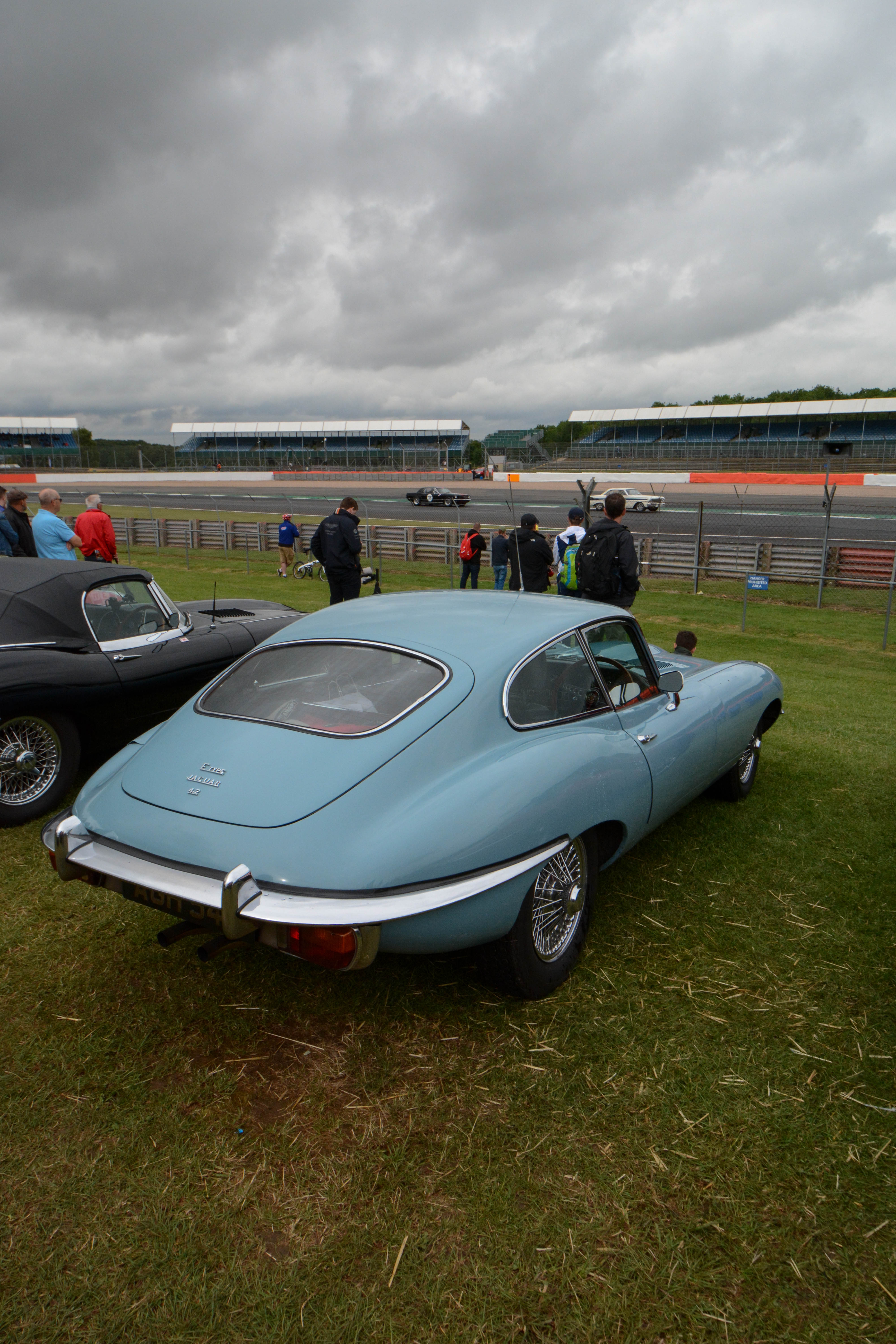
Soft-top or Coupe E-Type? On balance, I would have to go for a coupe as it is an aesthetically more complete design which is pleasing to the eye from any angle and it features that lovely side-hinged rear boot lid.

Of the XK series, the XK120 in Coupe or Open Top Sports (OTS) form is my absolute favourite as it has that purity of form of the original design. The Drop Head Coupe (DHC) model looked too cumbersome due to the necessarily extended soft top to accommodate the 2+2 seating arrangement.

The XK140 suffers from the addition of bulky looking front and rear bumpers which replaced the far more elegant quarter bumpers of the XK120.

The XK150 added even more weight and bulk to the original XK design but I’m more drawn to it than the XK140 as it looks like a rakish, cut-down 2-door version of the MkI/MkII saloon.
Lola T70
I’m a big fan of the Lola T70, especially the MkIIIB Coupe which is a thunderously powerful GT car thanks to its mid-mounted 5.3 Litre Chevy V8 engine. It’s great to see these cars rumbling around the track .

Development of the Lola T70 by Eric Broadley was in part funded by his fee for design and initial development of the Ford GT40.

This Lola was difficult to miss in the International Pit Garages with its wonderfully prepared bodywork and mechanical components. It turned out to be the ex John Mecom Racing Zerex Special Lola T70 Mk1 Spyder which was built in 1965.

The car was originally fitted with a Ford 4.7 Litre V8 engine but later in its extremely busy racing life it was fitted with a Chevrolet V8.

Chassis number SL70/13 is a fantastic car with an unbelievable racing history and thanks to the care and attention it has received, it has many more races left in it.
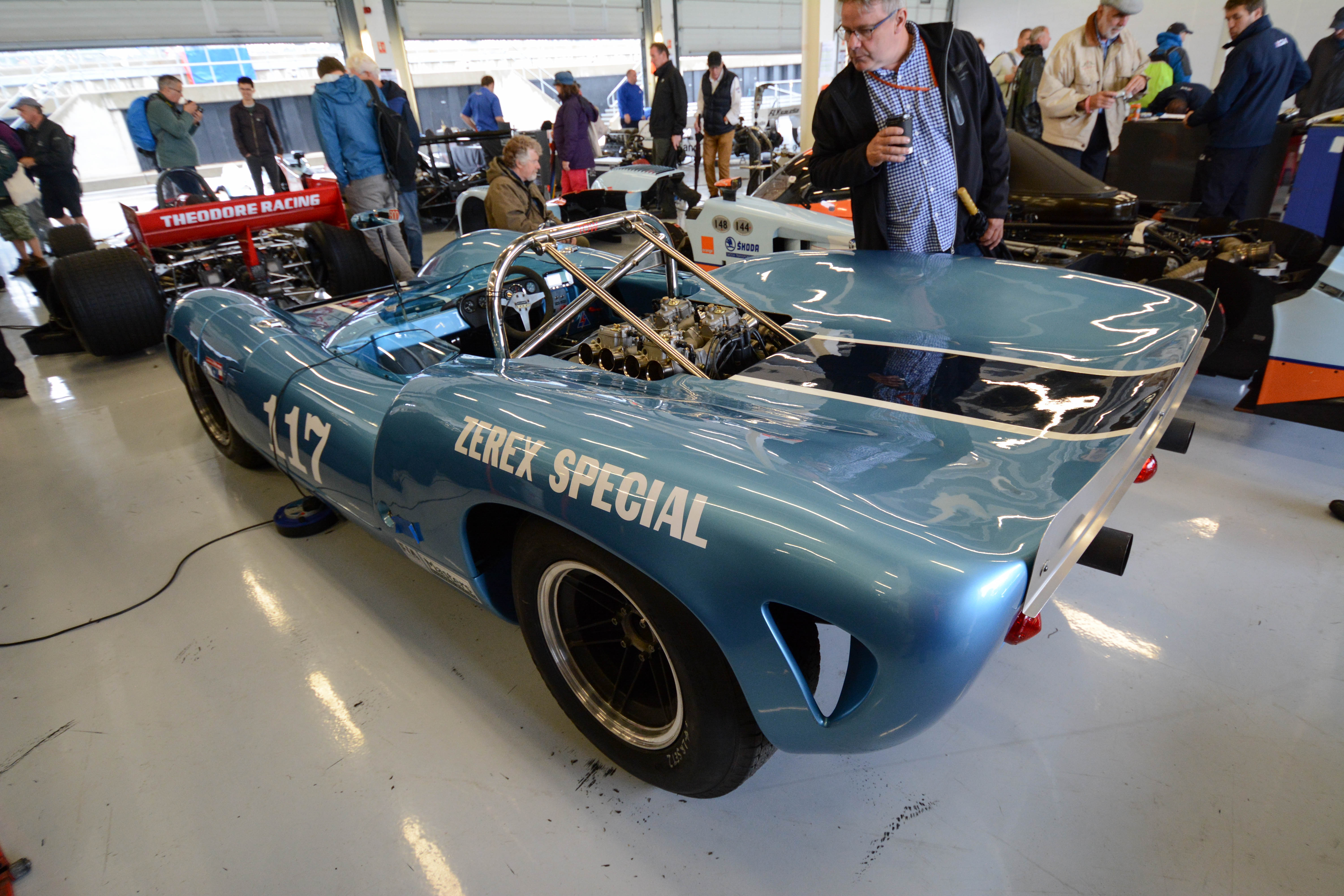
Maserati
The brothers Maserati (Alfieri, Bindo, Carlo and Ernesto) established one of the world’s most famous automotive marques. The Maserati trident badge has graced a wide range of incredible racing cars and luxurious and sporting road cars.
Before WWII, Maserati’s exclusively built racing cars but after the end of hostilities they built both racing and road cars and thankfully production continues to this day.
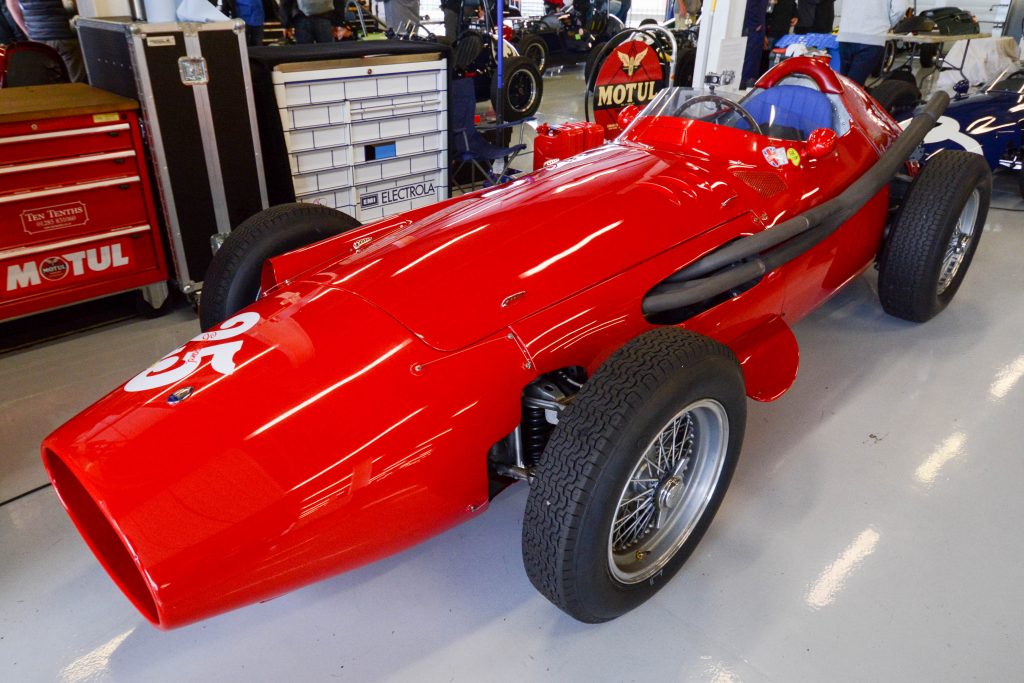
One of the most striking and successful post-war race cars was the 250F Formula 1 car. Powered by a 2,493 cc 270 bhp straight-6 engine, this little car enjoyed great success during the mid to late ’50’s in the hands of motor racing legends such as Juan Manuel Fangio, Stirling Moss, Prince Bira Chakrabongse and Jean Behra.
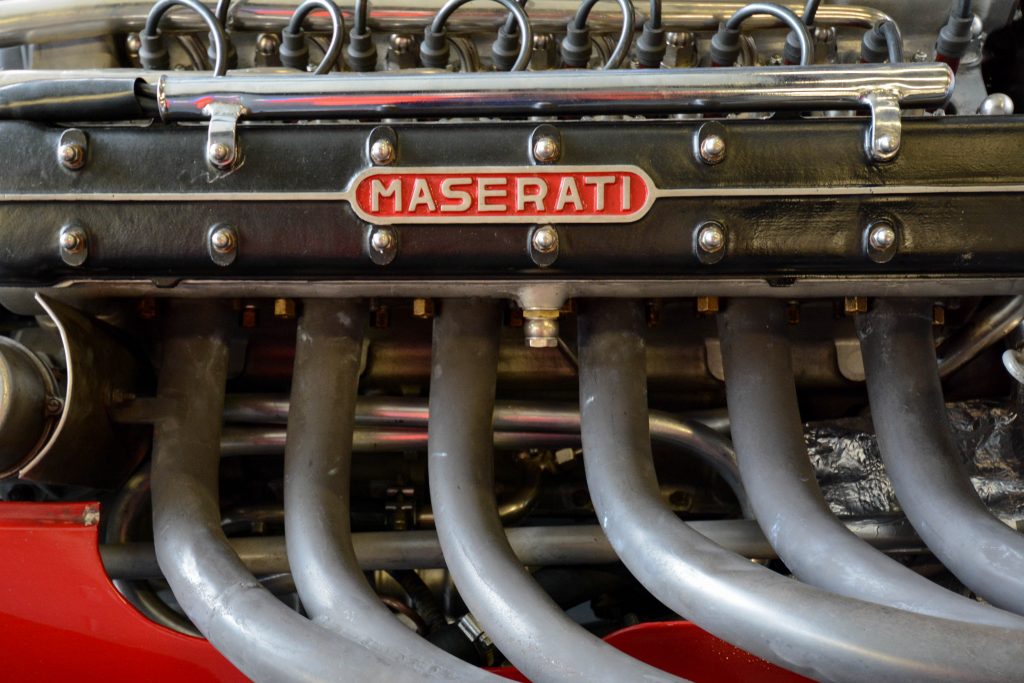
Only twenty six 250F’s were ever built so seen them being actively and enthusiastically raced in historic events is a great privilege.
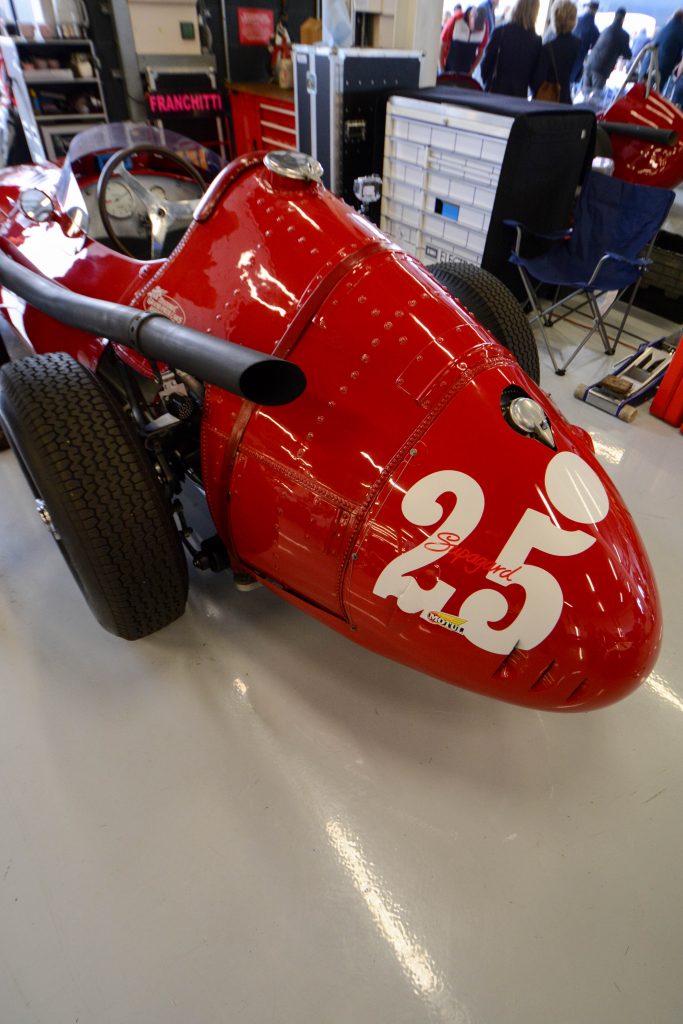
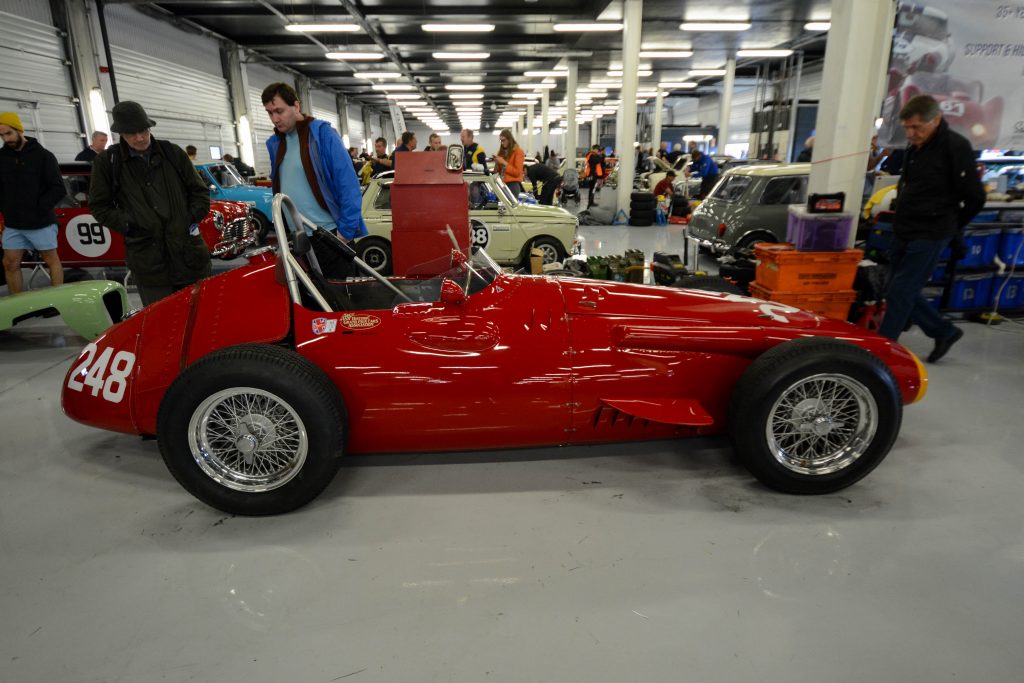
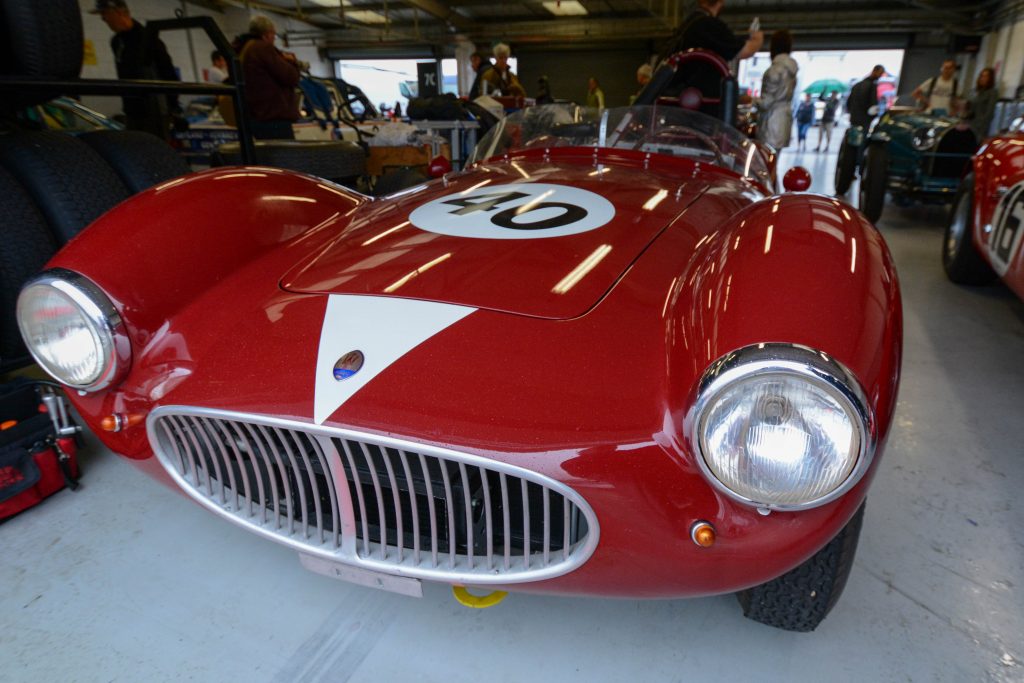
This A6GS Spyder looked stunning with its nose poking out of the pit garage ready to launch itself onto the circuit via the pit lane. Fifty two of these glorious cars were built between 1952 and 1955 based upon an initial Colombo design with subsequent refinements by Fantuzzi and Fiandri.
The “A” stands for Alfieri (one of the founding Maserati brothers) and “6” stands for 6 cylinders of the 2.0 Litre 127 bhp engine that powered this beautiful little 2-seater. “G” stands for GT and “S” for Sport
Morgan
Not quite the image that one normally conjours-up of a Morgan. Instead of the super-traditional body shape harking back to the 1930’s, this sleek GT was the creation of arch Morgan tuner and racer Chris Lawrence.
He was responsible for building this aerodynamically slippery aluminium bodied Morgan Plus 4 SLR in 1964 after having practised his body restyling skills first on a Triumph TR4.

The SLR in the cars name stood for Sprinzel Lawrence-Tune Racing incorporating the names of racing driver John Sprinzel and Chris Lawrence. Design of the the sleek bodywork was a joint effort by Chris Spender and Charlie Williams and the Standard/Triumph 2.1 Litre, 4-cylinder engine was of course tuned by Lawrence himself to Super Sport specification which delivered 156 bhp.

Only four cars were built in total primarily for racing and they proved to be reasonably competitive against more well established race cars of the period and thankfully all four cars survive to this day.
Stylistically, the SLR is quite an arresting car displaying some features reminiscent of early Corvette Stingrays and some of the much later Opel GT.

Piper
I still have a soft spot for Piper cars having almost bought one in the dim and distant past. Not the most practical of sports cars in terms of access, visibility and ventilation but undeniably pretty, the Piper would have benefited from greater development to make it a contender against other British Plastic of the period.

The company was founded in 1966 by George Henrotte who was ably assisted by Bob Gayler, Ken Packham and Tony Hilder. The company produced various one-off road and race cars and a range of tuning components before eventually launching their own GT kit-car in 1967 and a GTR Group 6 race car in 1968.
The car pictured here is a Piper P2 which followed on fro the earlier GTT. Although buyers of the kits could choose from a variety of engines, the most popular option was the 1600 cc Ford cross-flow pepped-up by Piper head and camshafts.
In this form, the Piper GTT and P2 provided an alternative to other popular kit cars of the period from the likes of TVR, Ginetta, Rochdale etc.

Porsche
I was a bit disappointed not have driven my Yellow Peril 911 2.2E to the event but heavy rain and the lack of an infield pass for the car made it rather pointless. Thankfully Porsche Club GB hosted quite a lot of members and their cars and that was a welcome relief given the awful weather.
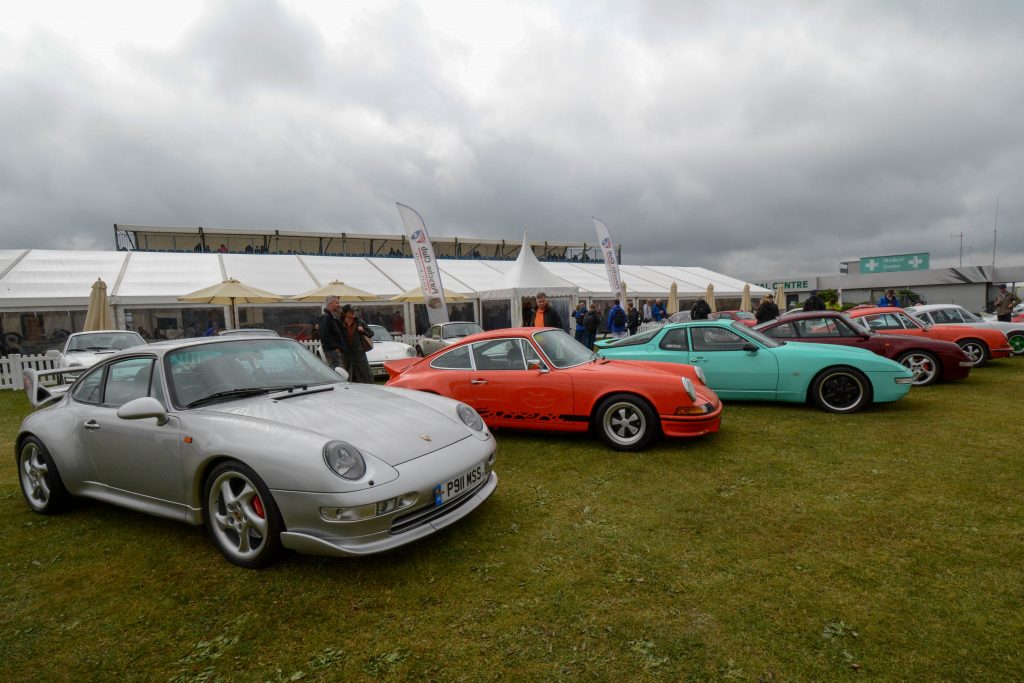
The club provided a tented sanctuary with free flowing coffee, some interesting cars on display and access to an exclusive Porsche Club covered stand to watch the racing.
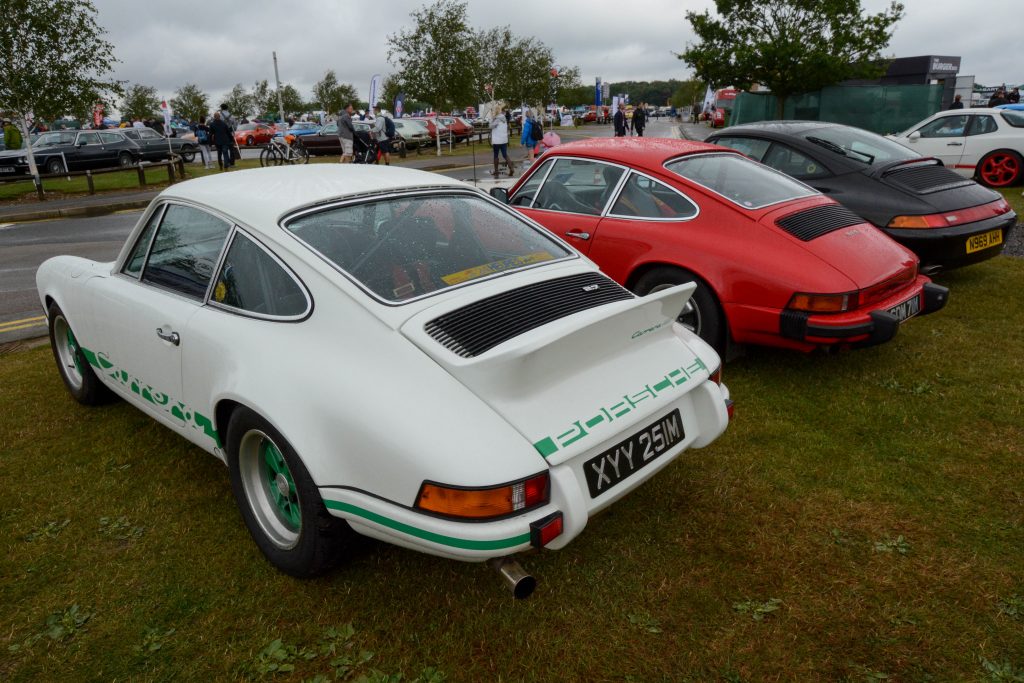
Upon arrival, I met up with my good friend Kirk who had managed to bring along his lovely 2.2S and we were able to mingle with other Porschephiles before exploring the pits and paddocks of Silverstone.

